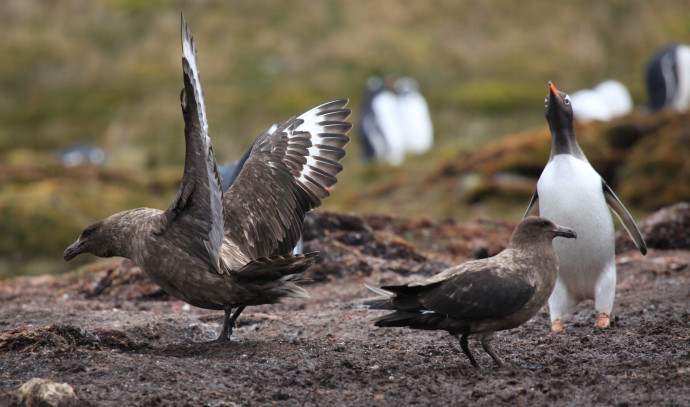Highly Pathogenic Avian Influenza (bird flu) was detected in brown skua birds on Bird Island on Sunday, marking the first cases of the virus detected in the Antarctic region and raising concerns of potential harm to penguin and seal populations.
Bird Island, located about 1,700 km off the southern tip of Argentina, is part of the British overseas territory of South Georgia and the South Sandwich Islands. The island is also claimed by Argentina as part of the Tierra del Fuego Province.
The British Antarctic Survey stated that it took samples from some birds on the island after reports of potentially symptomatic birds and unexplained mortality. The samples were sent to the UK’s Animal and Plant Health Agency where they tested positive for bird flu.
The British Antarctic Survey did not say what subtype of the virus the birds were infected with, although it did note that the birds were likely infected by birds who had returned from their migration to South America.
A large number of bird flu outbreaks have been reported in Europe and the Americas, including in South America. The main subtype circulating is the H5N1 subtype, although an outbreak of H7N6 was also recently reported in South Africa.
The British Antarctic Survey operates two research stations in South Georgia, including one on Bird Island. Research teams at the island have begun taking precautionary measures and have suspended the majority of field work involving animal handling. The teams are also conducting enhanced cleaning of clothing and field equipment and observing areas of high wildlife density.
“It is not possible to forecast the impacts of HPAI across South Georgia, given that the patterns of transmission and mortality in Europe and the Americas space has been highly variable. GSGSSI and BAS will continue to work together to monitor the impact of the wildlife at Bird Island, and the potential spread to other areas,” said the British Antarctic Survey.
Bird flu could devastate penguins and seals in Antarctica
In September, scientists expressed concerns that the outbreak could spread to Antarctica and devastate penguin and seal populations.
Dr Jane Rumble, OBE, told The Telegraph at the time that “It could be absolutely devastating. We’re saying when, not if.”
“Animals tend to concentrate together. Some sites will have gentoo penguins, chinstrap penguins, elephant seals, fur seals, and they’re all basically together,” added Rumble, explaining that the dense colonies could help the virus spread. “Their natural predators are in the water, so they don’t avoid each other on land.”
Since 2021, Europe and the Americas have been suffering from a nearly continuous outbreak of H5N1 avian influenza which has been described as “the largest-ever” outbreak on the three continents. The virus has affected tens of millions of birds and thousands of mammals across the world.
Amid the continuing global outbreak, a number of outbreaks have been reported in Israel.
The first outbreak of the season was reported at a petting zoo including over 200 peacocks, geese, ducks, guinea fowls, chickens, doves, and parakeets in Sde Ya’akov in northern Israel.
Since then, two additional cases have been reported, including an outbreak at a chicken coop containing 20,000 birds at Allonim in northern Israel, not far from Sde Ya’akov. The second case was reported on October 10, when a black stork was found to be infected at Ein HaMifratz between Haifa and Acre.
Before the outbreak in Sde Ya’akov, the last case of bird flu reported in Israel was in April, when an Armenian gull was found dead at the Habonim Beach Nature Reserve, north of Zichron Ya’akov.



